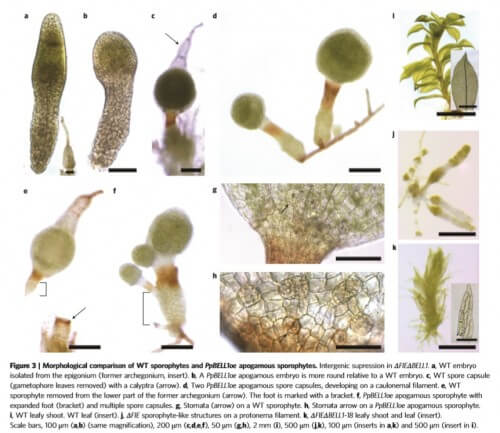The discovery may revolutionize agriculture and strengthen food security in the world

Researchers from Tel Aviv University have isolated a gene, the overexpression of which activates the mechanism of asexual reproduction in plants. The discovery may shed light on the evolutionary transition of species from sea to land and revolutionize agriculture.
The study, which began a decade ago, was conducted by two research groups: the group of Prof. Nir Ohad, a member of the department of molecular biology and plant ecology and director of the Man Center for Food Safety and Security at Tel Aviv University, with the participation of research fellow Dr. Aviva Katz and Dr. Idan Perman from the faculty of Life Sciences at Tel Aviv University, and the group of Prof. Ralph Rasky, Head of the Department of Plant Biotechnology at the University of Freiburg in Germany, with the participation of PhD student Nelly Hors and the director of the research group Dr. Eva Dekker. The results of the research were published last night (18.1) in the prestigious journal Nature Plants.
"As a general rule, one should distinguish between sexual reproduction and asexual reproduction," explains Prof. Ohad. "In sexual reproduction, two gametes unite to form the next generation. Since gametes from different parents come with a different genetic load, the offspring will contain half of the genes of each parent. Evolutionary 'logic' has led to the creation of different offspring, each of which may be slightly differently adapted to the environment. This diversity ensures survival. If we all become exactly the same, a new state could wipe out the entire species. On the other hand, it is not always possible to find a sexual partner for reproduction. A plant that grows in an environment that makes it difficult for it to pollinate, for example, will still be able to grow identical offspring if it has the ancient mechanism of asexual reproduction. It's a kind of evolutionary backup of the plant."
One such plant, which reproduces sexually, is a moss of the type Physcomitrella patens, which was chosen as the model plant for the study. Through the expression of a single gene called BELL1 in all tissues of the plant, the researchers caused the moss to produce embryos not in the reproductive systems but in a tissue similar to the "stems" of the moss. These identical embryos developed into adults that produced fertile offspring of their own.
"We isolated one specific gene, which we have been looking for for a long time in all kinds of plant systems," says Prof. Ohad. "By expressing this gene, we bypassed the need for the reproductive process and reproductive systems, and caused the plant to create the next generation independently and without fertilization. The gene we identified is under epigenetic control in the plant, a system that is responsible for gene expression according to feedback from the internal and external environment. In the language of the question, the epigenetic system is like a system of Biblical meanings: it does not change what is written, in this case the genetic code, but guides how it should be read and interpreted. By expressing the BELL1 gene in the plant, we caused the system to activate the plant's genetic code, possibly similar to natural situations such as under stress conditions, which cause it to reproduce without a partner."
The researchers hope that the new research will be a breakthrough in understanding the formation of unfertilized embryos. "The process of creating embryos during evolution requires intermediate stages, from a situation where the embryo was one-celled to a situation where the embryo began to divide and form the multicellular body that characterizes all land plants today. From a scientific point of view, there is still more hidden than visible in asexual reproduction, and in the transition from asexual reproduction to sexual reproduction. This is the key to understanding the beginnings of a new life."
In addition, since this gene is conserved among plant species, understanding the mechanism underlying asexual reproduction can pave the way for activating a similar process in crop plants as well, thus producing seeds from selected plants without the use of gametes - a clone that will allow rapid multiplication of the target plants, storing them as seeds and distributing them to farmers with simple means and low costs.
"This is the dream of the seed companies," explains Prof. Ohad. "Natural genetic replication, which will be done by the plant itself, is the name of the game in agriculture, since it gives uniformity. The seed companies invest money and time to improve and create superior varieties, which will have the desired properties and the right nutritional parameters, plants whose fruits have a good taste, which are resistant to diseases and so on. We want to reproduce these strains without involving sex cells. The nutritional and economic potential here is enormous. Creating identical seeds will make it possible to preserve them for a long time, and to market and distribute them to farmers in an easy and cheap way, something that can significantly strengthen food security in the world."

3 תגובות
Pineapple prices have finally come down!
Like anything, you can do good or bad with it. If in the future they perform asexual reproduction in animals and humans.
It is possible to reach a distant planet and reproduce on one. Dangerous - without genetic diversity.
On the other hand, it is possible to create an army of creatures that are almost one.
Soon they won't need bees for the fruits